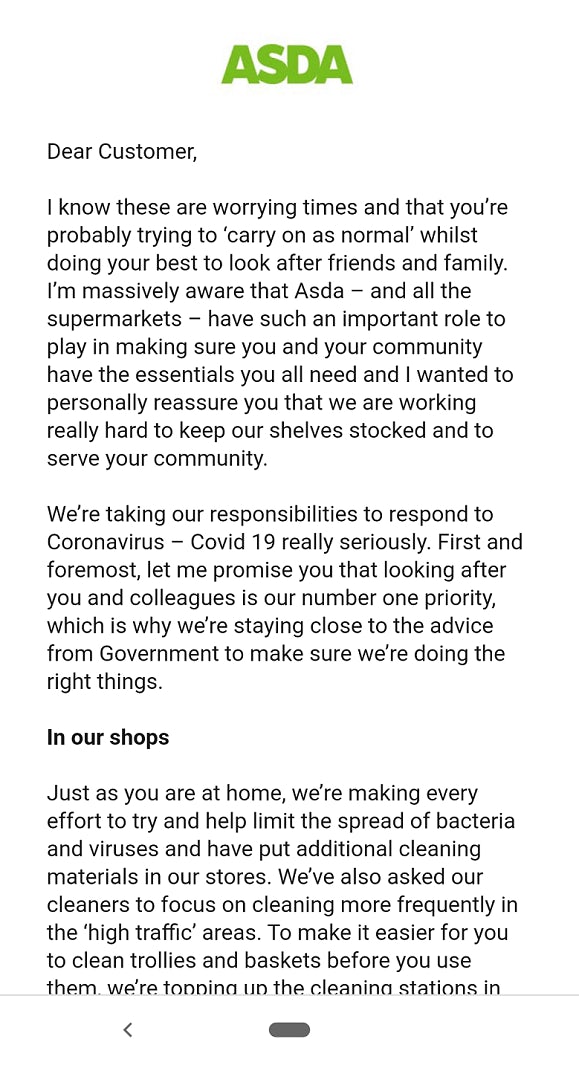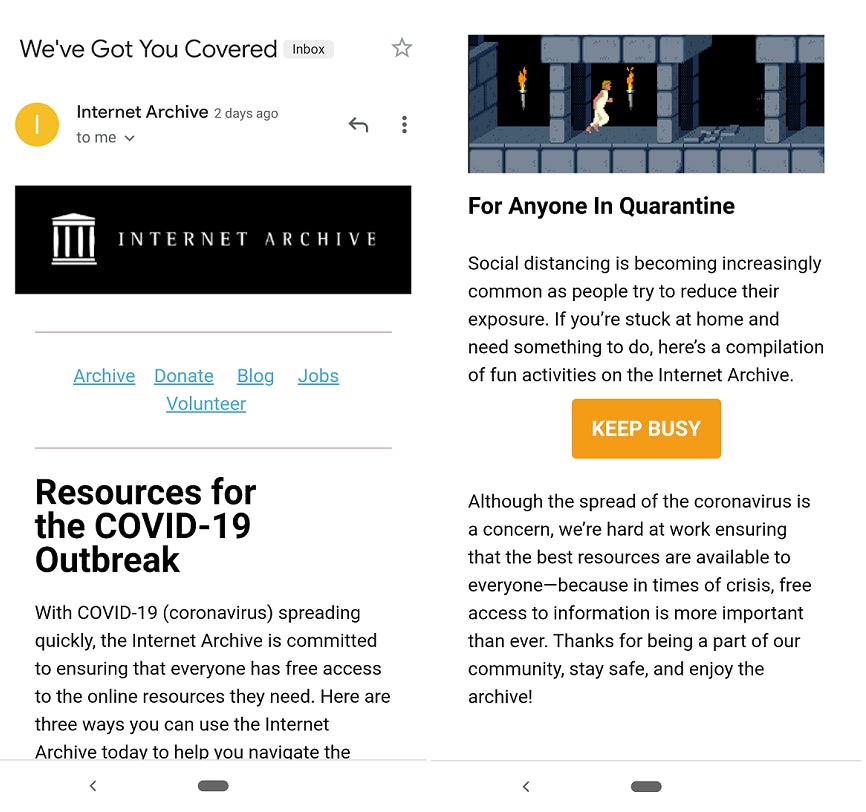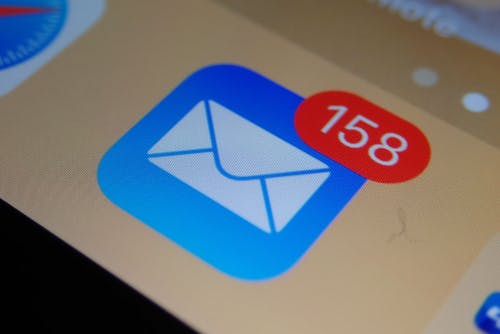Consumers are receiving email on a level unseen since GDPR as brands and businesses race to reassure them over the unfolding situation with coronavirus and pre-empt any concerns that they might have.
And much like GDPR, jokes are already springing up online about some of the more unwarranted and unusual emails that have landed in people’s inboxes:
Just got an email from my university’s career strategy office, saying they’re fully operational for all our career questions in this confusing and stressful time, and reader, I laughed
— maryam مریم ivette (@MIParhizkar) March 18, 2020
Unlike GDPR, however, where companies did have a reason to be reaching out to their customers and notifying them of privacy policy updates (although there is still debate over whether the deluge of emails was necessary), the situation with coronavirus is a lot more uncertain. Brand opportunism is going to be viewed particularly poorly at this time – and the backlash for companies who are perceived to strike the wrong tone or be jumping on the bandwagon in the middle of a crisis could be severe.
While the temptation is undoubtedly strong to ‘weigh in’ in some fashion and make sure that your business is in communication with customers during a fraught time, following some common-sense guidelines will help prevent your brand’s email from turning up in a mocking social post or round-up of unwanted emails – or worse, from damaging your brand at a time when very few businesses can afford to.
Do
Provide specific updates on how normal service will be impacted
Most businesses are reaching out to either reassure customers about measures they are taking to keep them safe in the midst of the outbreak (extra cleaning precautions, financial protection, etc.) or to inform them of ways that the business or service will be impacted (limited stock, shipping delays, staff working remotely).
Either way, try to give specifics. What measures have been taken, and how will those help the situation? How has the business/service been impacted, and what does that mean for customers? Is there a helpline they can contact or a webpage they can refer to for more information?
Don’t fill up the space with empty waffle – people will already have email fatigue from receiving so many of these kinds of communications, so their patience and their attention span will be limited. Be sure to use clear, precise language and easy-to-scan formatting – for example, bullet points and headers that highlight key information.
Do provide information about online options or alternatives
It’s safe to assume that the bulk of the people receiving your message will want to go out as little as possible, if they are able to leave the house at all. Therefore, wherever possible, provide information about online options or alternatives.
If you’re a fitness centre, are there online fitness videos people can watch or a training app they can download? If you’re a restaurant or food business of any kind (no matter how small), can customers place orders online for delivery or collection? If staff are no longer going to be present in your branches or call centres, how can customers contact your brand online?
If you aren’t offering online alternatives or services for your business, now might be the time to start putting those in place.
Do tailor your language to the situation
It probably goes without saying, but now is not the best time for irreverent jokes or edgy humour, no matter how on-brand it might be. That doesn’t mean that your update needs to be dreary or in dry legalese, but read the room, so to speak. Your customers are going to be on edge and anxious; they might well have loved ones who have been taken ill, or are afraid that they might be. They may also be worried about their financial situation, their living situation, food supplies or their children’s education and future.
In short: tread lightly. It’s okay to strike a positive or reassuring tone, but do so with care. And get as many people from all levels of your organisation to proofread and feed back on the message as you can.
Do direct people to your website
Many brands are falling into the trap of only making this information available via email – but it should be on your website as well. If you’re expecting there to be a significant impact, or a significant volume of queries, due to coronavirus, then it’s worth creating a page for information and updates, perhaps even a dedicated FAQ.
Make sure this is well-signposted and not just tucked away in a footer link – and direct customers to it from your email. This allows you to be more concise in your message, with a link in the email for further information (you may also want to direct your customers to where they can send queries or receive additional support).
Don’t
Use this as a re-engagement opportunity
While this shouldn’t need saying, too many consumers have recently reported hearing from companies that they haven’t bought with in years – or at all. Some of the earliest brands I heard from myself were hotel services that I’d only ever made a one-off booking with, and definitely didn’t have any active bookings with.
The current situation with coronavirus should in no way be seen as an opportunity to ‘re-engage’ a mailing list or entice former customers to come back to your brand – it’s simply not appropriate. At best it will result in customers feeling unsettled by you contacting them out of the blue – at worst they may be turned off your brand completely, and will probably tell their friends about the experience as well.
It goes without saying, I hope, that any contact details you use should have been obtained on an opt-in basis (GDPR…) and not via a third-party mailing list or other shady means. Beyond that, try to filter for customers that you have a current, active relationship with and not those who might have signed up for account five years ago and forgotten about it. One, they will be most receptive to your message and probably welcome the update; and two, as previously stated, they will have received a lot of email already and will be liable to ignore messages from brands they don’t have good reason to hear from.
Don’t send out emails for the sake of it
As a follow-on from the previous point, if you are making contact with customers at this time, it should be because you have something to say to them. If you don’t have any update to provide, or information to communicate, it’s best to stay out of people’s inboxes.
However, now is a good time to review any upcoming campaigns that you might have (email or otherwise) in light of the situation – are they still appropriate? Do their tone, imagery or themes have any unfortunate implications for the situation? Can you tailor them to the situation that people are likely to be in (probably indoors, not going out to meet up with friends or coming into contact with many other people) or offer something that will be of genuine use to customers at this time (like free access to, or a discount on, online products or services)?
Think about what people are most likely to need from your brand or service that you can provide – whether it’s a light distraction in the midst of the chaos, a product, or a resource. Check out this round-up of brands who are doing this effectively with their marketing messaging for inspiration.
Don’t make light of the situation – or encourage people to ignore health advice
Some of the messages from businesses around the coronavirus outbreak have struck a jarring tone, as instead of taking it – or their customers worries’ – seriously, they seem more concerned about keeping up potential business and encouraging people to act like nothing was happening. Take for example this outreach that my colleague Seán Donnelly received from a local business earlier this week:
Not impressed that @VennStRecords @NorthcoteRcrds have used #covid19UK as a cheap opportunity to email me to say they’ve got loads of hand sanitisers and so are business as usual. So much for safe distancing. I won’t be back ?
— Seán Donnelly (@Seanog1982) March 16, 2020
As I advised earlier, read the room – and don’t encourage customers to ignore government or health advice for the sake of spending money with your business. It’s likely to be much better-received if you can find a creative way to connect with them, provide them with needed information, or offer them something that they really need at the present time.
Some stand-out examples of email communication
So, which brands have been doing this effectively? Here are some stand-out examples of brands who have communicated with their customers in useful, valuable and respectful ways during the coronavirus outbreak.
Asda
As supermarket shelves have increasingly been ransacked of essential and non-essential goods, it has fallen to supermarket brands to reassure customers about their stock availability and update them on the way they are handling the crisis. I was impressed by the communication I received from Asda, which acknowledged that families were doing their best to carry on as normal while looking after each other, and outlined the measures that Asda was taking to ensure it could be there for customers.

In particular, the supermarket brand asked customers who were placing online orders to try to be flexible in their delivery times if possible, and explained how they could let Asda know if they were self-isolating, as well as the measures that drivers would take when delivering food to self-isolating customers.
The company later followed up with an additional message to highlight measures it was taking to support vulnerable customers who most needed access to supplies, including setting aside an hour in the early morning for them to shop. Other supermarkets like Sainsbury’s and Iceland have taken similar measures.
How is coronavirus impacting the retail industry?
Etsy
Online marketplace for handmade, vintage and craft goods Etsy moved quickly to reassure its sellers, many of whom are small or independent businesses, as the coronavirus outbreak escalated. It emphasised that supporting its community and ensuring their safety was its top priority and gave a list of suggestions for shop owners on how to cope with the disruption to their normal business routine, including setting realistic expectations before making commitments to buyers, communicating about potential dispatch delays, and pausing their shop temporarily if they were unable to continue managing it.
The email also linked to Etsy’s help centre for more information and support, which contains further advice on managing a shop during the outbreak and also features rolling updates on government announcements that might affect international shipping or cargo.
The only weak point in Etsy’s otherwise very thorough provision of information is that it’s not highlighted on the front page of the website – meaning that sellers who missed the email or are visiting the site as a first point of call are less likely to see it.
The Internet Archive
While not the first brand you might think of during a global pandemic, The Internet Archive sent out a funny and worthwhile email to account-holders with a list of resources to keep them occupied during the COVID-19 outbreak, highlighting its extensive stock of free films, documentaries, learning resources and data.
The email was also visually appealing, divided into sub-sections including “For Parents and Educators” and “For Fact-Checkers”, and included large, colourful buttons that readers could tap to access more resources and information on the Internet Archive – such as a round-up of ‘7 Things To Do If You Can’t Leave The House’.

Santander
In the midst of a crisis that has put hundreds of thousands of people out of work and what looks to be a global recession, people are understandably panicking about their finances. Santander sent out an email to reassure its customers and inform them of ways it would be able to help them if they were suffering financially.
It also informed customers that its call centres would have reduced staffing levels due to the need to reduce the number of workers in-branch, and advised them of ways that they could get in touch online and manage their money via online or mobile banking. Santander’s website also carries a prominent banner which directs visitors towards its tips and information for helping them manage their money.








